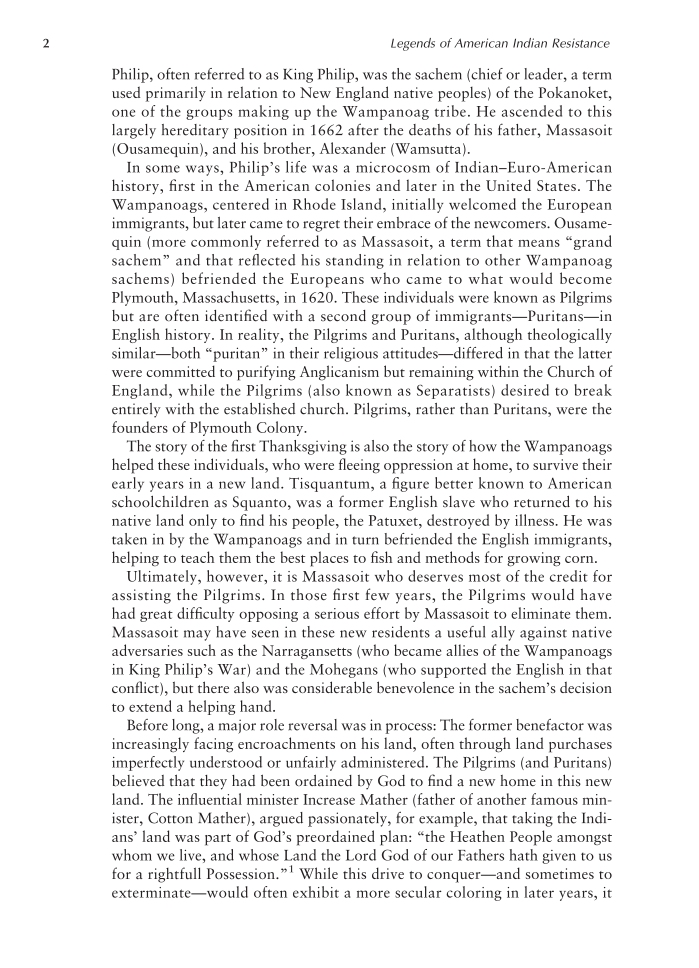Philip, often referred to as King Philip, was the sachem (chief or leader, a term used primarily in relation to New England native peoples) of the Pokanoket, one of the groups making up the Wampanoag tribe. He ascended to this largely hereditary position in 1662 after the deaths of his father, Massasoit (Ousamequin), and his brother, Alexander (Wamsutta). In some ways, Philip’s life was a microcosm of Indian–Euro-American history, first in the American colonies and later in the United States. The Wampanoags, centered in Rhode Island, initially welcomed the European immigrants, but later came to regret their embrace of the newcomers. Ousame- quin (more commonly referred to as Massasoit, a term that means “grand sachem” and that reflected his standing in relation to other Wampanoag sachems) befriended the Europeans who came to what would become Plymouth, Massachusetts, in 1620. These individuals were known as Pilgrims but are often identified with a second group of immigrants—Puritans—in English history. In reality, the Pilgrims and Puritans, although theologically similar—both “puritan” in their religious attitudes—differed in that the latter were committed to purifying Anglicanism but remaining within the Church of England, while the Pilgrims (also known as Separatists) desired to break entirely with the established church. Pilgrims, rather than Puritans, were the founders of Plymouth Colony. The story of the first Thanksgiving is also the story of how the Wampanoags helped these individuals, who were fleeing oppression at home, to survive their early years in a new land. Tisquantum, a figure better known to American schoolchildren as Squanto, was a former English slave who returned to his native land only to find his people, the Patuxet, destroyed by illness. He was taken in by the Wampanoags and in turn befriended the English immigrants, helping to teach them the best places to fish and methods for growing corn. Ultimately, however, it is Massasoit who deserves most of the credit for assisting the Pilgrims. In those first few years, the Pilgrims would have had great difficulty opposing a serious effort by Massasoit to eliminate them. Massasoit may have seen in these new residents a useful ally against native adversaries such as the Narragansetts (who became allies of the Wampanoags in King Philip’s War) and the Mohegans (who supported the English in that conflict), but there also was considerable benevolence in the sachem’s decision to extend a helping hand. Before long, a major role reversal was in process: The former benefactor was increasingly facing encroachments on his land, often through land purchases imperfectly understood or unfairly administered. The Pilgrims (and Puritans) believed that they had been ordained by God to find a new home in this new land. The influential minister Increase Mather (father of another famous min- ister, Cotton Mather), argued passionately, for example, that taking the Indi- ans’ land was part of God’s preordained plan: “the Heathen People amongst whom we live, and whose Land the Lord God of our Fathers hath given to us for a rightfull Possession.”1 While this drive to conquer—and sometimes to exterminate—would often exhibit a more secular coloring in later years, it 2 Legends of American Indian Resistance
Document Details My Account Print multiple pages
Print
You have printed 0 times in the last 24 hours.
Your print count will reset on at .
You may print 0 more time(s) before then.
You may print a maximum of 0 pages at a time.










































































































































































































































































































































































